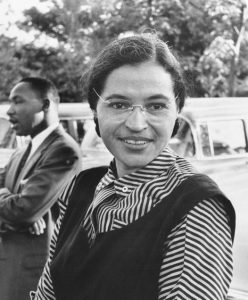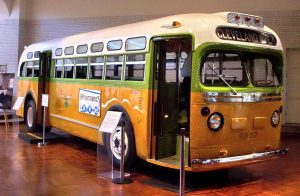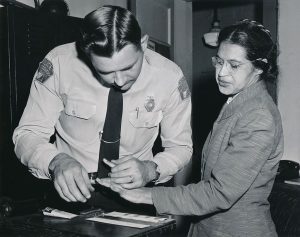The Civil Rights Movement of the 1950s and 1960s was tremendously a monumental time in United States history . This was a time for reform for the Black community, as they were attempting to earn the equality and freedom they deserved as individuals and citizens of the United States of America. Pictured below is the photograph of a woman, whom in which extraordinary ways took it upon herself to take a stand for not only her, but her entire Black community in what she thought was right. Rosa Parks was a determined and fearless civil rights activist who was not afraid of letting her voice be heard.

An image of Rosa Parks (1955) and pictured behind her is Dr. Martin Luther King, fellow Civil Rights Activist.
She is most known for her actions that began the Montgomery Bus Boycott. Parks, like every other day, would take her routine bus home from work, and did her duty by paying her fare to the bus driver, and taking her designated seat in the back of the bus, or also known as the “Black section.’ During this time, segregation was a very lively thing, especially in the southern part of the United States, specifically Montgomery, Alabama. At one of the stops, a platoon of white passengers boarded the bus, and a white man was left without a seat and remained standing.

An image of the bus where Rosa Parks refused to give up her seat to a white man.
Author Viv Sanders addresses Rosa Parks and her movements in the piece, “Rosa Parks & the Montgomery Bus Boycott” by vividly describing a specific altercation by stating, “The bus driver asked Parks and the other blacks in the row to get out of their seats so that the white man would be able to sit down and not have to sit alongside black people. While the other three black passengers obediently gave up their seats, Parks refused. The bus driver stopped the bus, called the police, and Parks was arrested” (Sanders 4). [1]

This photograph shows Rosa Parks getting fingerprinted after arrest for her actions of refusing her seat to a white man on public transportation.
People were infuriated with the news of her arrest, as she was simply taking a stand for her community, and doing what she sought out to be right. Rosa Parks’ arrest then sparked the beginning of protests and overall boycotting of the Montgomery buses (Alderman 177).
Rosa Parks was a symbolic presence for the Black community during this time. Author Emilye Crosby states in her discussion and representation of Parks as “a life-long activist who refused to passively accept abuse and was more com-mitted to dignity and self-determination than integration” (Jeffries 132). She was an activist, who in which taking part of larger organizations stances such as the NAACP, she, in her own ways, expressed her gratitude and strong feelings. “Parks is often represented in conventional Movement lore as a simple, tired seamstress whose quiet refusal to go to the back of the bus sparked a boycott. In reality, she was a trained activist and a vocal opponent of segregation whose conscious act of civil disobedience was part of a larger plan of resistance among Montgomery African Americans” (Alderman 175).
The picture captures Rosa Parks on the Montgomery Area Transit bus, taking her daily commute. Unbothered, Parks sits by herself in front of white man. The irony to this photograph is astonishing, considering the event occurred after the photo, as the white man is peacefully sitting behind her. This also gives off some type of message as well, as he is seated behind her, when most segregation entailed the blacks be seated in the back of the bus, giving off the conclusion that white people were superior to them, and were given the better treatment of sitting in the front of the bus. [2]
“Student and faculty volunteers from Alabama State University stayed up all night to distribute 35,000 flyers denouncing the arrest of Rosa Parks and urging support for the Montgomery bus boycott” (Shi 1172). The boycott for the Montgomery system lasted around thirteen months until the Supreme Courts’ overall say on outlawing any type of segregation matters on any forms of public transportation, which of course, included the Montgomery Bus System. The push for equality was now greater than ever in the times of the Civil Rights movement, as this incident sparked so much controversy, and made the black community realize they have had enough and was time for their voices to be heard, and demand the equality they deserve. Many activists like Rosa Parks, including the famous Martin Luther King Jr. sacrificed their freedoms for the sake of others, and all for standing up for what they believed to be right for not only themselves, but the community of their people across the nation of the United States.
[1] Sanders, Viv. “Rosa Parks & the Montgomery Bus Boycott.” History Review, no. 55 (September 2006):8.
[2] Alderman, DerekH., Paul Kingsbury, and OwenJ. Dwyer. 2013. “Reexamining the Montgomery Bus Boycott: Toward an Empathetic Pedagogy of the Civil Rights Movement.” ProfessionalGeographer
[3] Jefferies, Hasan Kwame. “Not That Kind of Tired: Rosa Parks and Organizing the Montgomery Bus Boycott.” In Understanding and Teaching the Civil Rights Movement. University of Wisconsin Press. 2019

this was helpful for my project on Mrs.Rosa parks <3